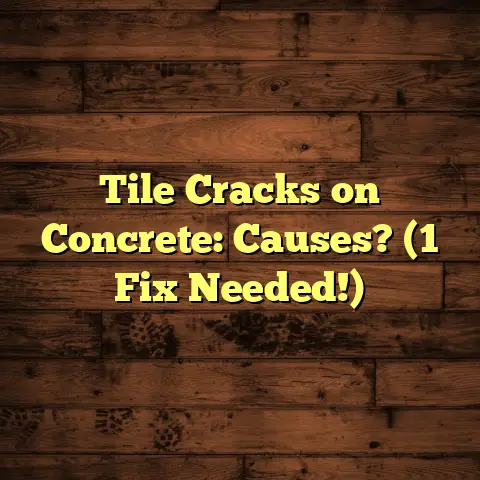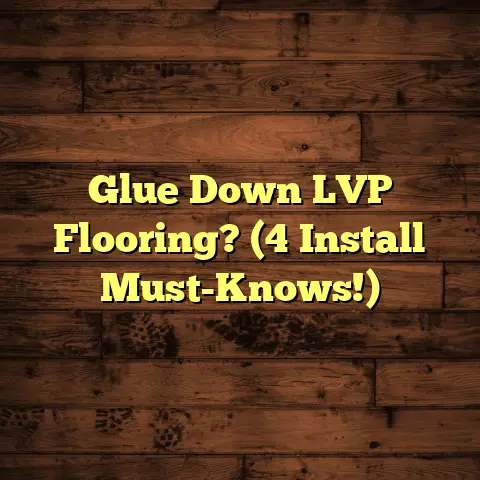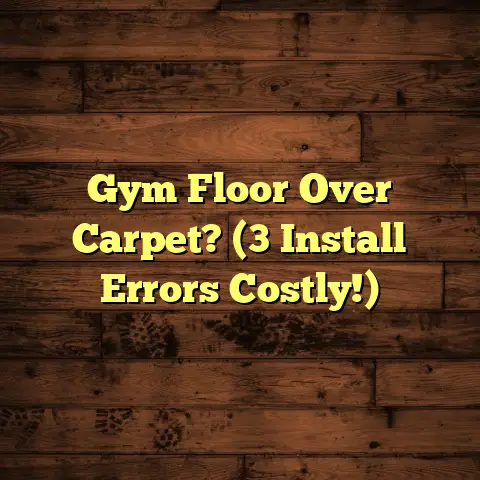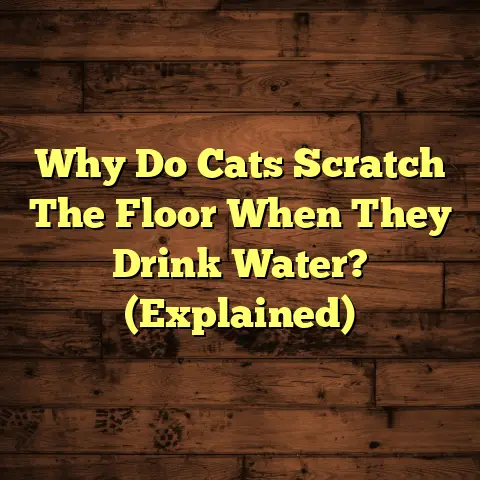How To Buff Vinyl Floors Like A Pro (7 Tips)
Vinyl flooring has exploded in popularity,
and for good reason.
It’s tough, looks great,
and doesn’t break the bank.
I’ve installed and maintained miles of vinyl flooring in my career, and I’ve seen firsthand how proper care can make a huge difference.
One of the best ways to keep your vinyl looking its best is through regular buffing.
Think of it as a spa day for your floors, bringing back that showroom shine and extending its life.
Now, you might be thinking, “Buffing? Sounds expensive!”
But it doesn’t have to be.
In this article,
I’m going to share my insider secrets
for buffing vinyl floors like a pro,
all while keeping your budget in check.
We’ll cover everything from understanding your vinyl to choosing the right products and techniques.
I’ll even share some common mistakes to avoid and how to protect your floors after buffing.
Ready to get started?
Here’s what we’ll be covering:
- Clean Thoroughly Before Buffing
- Choose the Right Buffing Products
- Use the Correct Buffing Technique
- Maintain the Right Buffing Schedule
- Avoid Common Mistakes
- Protect Your Floors After Buffing
- Know When to Call in the Professionals
By the end of this guide, you’ll have all the knowledge you need to achieve professional-looking results without breaking the bank.
Let’s dive in!
Understanding Vinyl Floors
So, what exactly is vinyl flooring?
It’s a synthetic flooring made from polyvinyl chloride (PVC) and other compounds.
What’s great about vinyl is that it comes in a variety of forms, each with its own unique characteristics:
Sheet Vinyl: This comes in large rolls and is great for areas that need water resistance, like bathrooms and kitchens.
It’s also typically the most budget-friendly option.Luxury Vinyl Plank (LVP): LVP mimics the look of hardwood, offering realistic textures and patterns.
It’s more durable than sheet vinyl and often comes in click-lock systems for easy installation.Luxury Vinyl Tile (LVT): Similar to LVP, but designed to resemble stone or ceramic tile.
It’s a fantastic alternative to traditional tile, offering warmth and comfort underfoot.
Vinyl flooring has a ton of advantages:
-
Durability: It can withstand heavy foot traffic, making it ideal for busy households.
-
Ease of Cleaning: A quick sweep and mop are usually all it takes to keep vinyl looking its best.
-
Affordability: Compared to hardwood or tile, vinyl is a much more budget- friendly option.
-
Water Resistance: Many vinyl options are highly water-resistant, making them suitable for kitchens and bathrooms.
Over time, even the toughest vinyl floors can show wear and tear.
Scratches, scuffs, and a buildup of dirt and grime can leave your floors looking dull and lifeless.
That’s where buffing comes in.
Buffing removes those surface imperfections, restoring the shine and luster of your vinyl.
It’s like hitting the reset button on your floors, making them look new again.
Budget Options for Buffing Vinyl Floors
Now, let’s talk about how to buff your vinyl floors without emptying your wallet.
You don’t need to spend a fortune to achieve professional-looking results.
There are several budget-friendly options to consider:
DIY Methods Using Household Items:
You’d be surprised at how effective common household items can be for cleaning and buffing vinyl floors.
Vinegar and Water: A solution of white vinegar and water can effectively clean vinyl floors without leaving a residue.
Mix about 1/2 cup of white vinegar per gallon of warm water.
Mop the floor with the solution, then rinse with clean water and dry thoroughly.-
Baking Soda Paste: For stubborn stains or scuff marks, create a paste of baking soda and water.
Gently rub the paste onto the affected area with a soft cloth, then rinse with clean water and dry.
Affordable Buffing Machines or Equipment:
While hand-buffing can work for small areas, a buffing machine will make the job much easier and more efficient, especially for larger spaces.
You don’t necessarily need to buy one; renting is a great option.
-
Floor Buffers: These machines are designed specifically for buffing floors.
You can rent them from most home improvement stores for a reasonable daily rate.
For example, Home Depot rents floor buffers for around \$30-\$50 per day, depending on the model and location.
Source: Home Depot Rental Services
-
Microfiber Mops: These mops are excellent for applying buffing solutions and achieving a smooth, even finish.
They’re also very affordable, with prices ranging from \$15-\$30.
Cost Comparison: Professional vs. DIY
To give you a clearer picture of the potential savings, let’s compare the costs of professional buffing services versus DIY methods:
As you can see, DIY methods can save you a significant amount of money.
Even with the cost of renting a buffing machine, you’ll still come out ahead compared to hiring a professional.
Tip 1 – Clean Thoroughly Before Buffing
Before you even think about buffing, it’s crucial to clean your vinyl floors thoroughly.
Buffing over dirt and grime will only grind those particles into the floor, making the problem worse.
Think of it like exfoliating your skin; you need a clean surface to start with!
Here’s how to prepare your floor:
Clear the Area: Remove all furniture, rugs, and other items from the room.
This will give you plenty of space to work and prevent any accidental damage.-
Sweep or Vacuum: Use a broom, dust mop, or vacuum cleaner to remove loose dirt, dust, and debris.
Pay special attention to corners and edges, where dirt tends to accumulate.
-
Mop with a Cleaning Solution: Prepare a cleaning solution using warm water and a mild detergent or vinyl floor cleaner.
I typically use a pH-neutral cleaner to avoid damaging the vinyl.
Mop the floor thoroughly, making sure to cover every area.
-
Rinse with Clean Water: After mopping with the cleaning solution, rinse the floor with clean water to remove any residue.
Use a clean mop or cloth to dry the floor thoroughly.
Common Cleaning Mistakes to Avoid:
-
Using Abrasive Cleaners: Avoid using abrasive cleaners, scouring pads, or steel wool, as they can scratch and damage the vinyl surface.
-
Using Too Much Water: Excessive water can seep into the seams and cause damage to the subfloor.
Always use a damp mop, not a soaking wet one, and dry the floor thoroughly after cleaning.
-
Skipping the Rinse: Failing to rinse the floor after cleaning can leave a dull film on the surface.
Always rinse with clean water and dry the floor to ensure a streak-free finish.
Tip 2 – Choose the Right Buffing Products
Selecting the right buffing product is essential for achieving the desired results.
There are several options available, each with its own pros and cons:
-
Floor Wax: Wax provides a protective layer and a high-gloss shine.
However, it can also be prone to yellowing and buildup over time.
I generally recommend using wax sparingly and only on floors that are specifically designed for waxing.
-
Floor Polish: Polish is similar to wax, but it’s typically easier to apply and remove.
It provides a good level of shine and protection, but it may not be as durable as wax.
-
Floor Sealers: Sealers create a protective barrier that helps prevent stains, scratches, and other damage.
They don’t necessarily provide a high-gloss shine, but they can extend the life of your vinyl floor.
Budget-Friendly Recommendations:
-
Rejuvenate All Floors Restorer: This product is a popular choice for restoring shine to vinyl floors.
It’s easy to apply and provides a durable, long-lasting finish.
It typically costs around \$20-\$30 per bottle.
-
Weiman High-Traffic Hardwood Floor Polish & Restorer: While marketed for hardwood, this product can also be used on vinyl floors to add shine and protection.
It’s available at most major retailers and costs around \$10-\$15 per bottle.
Choosing the Right Product for Your Vinyl:
-
Sheet Vinyl: For sheet vinyl, I recommend using a polish or sealer that is specifically designed for vinyl floors.
Avoid using wax, as it can be difficult to remove and may damage the vinyl.
-
Luxury Vinyl Plank (LVP) and Tile (LVT): For LVP and LVT, you can use a polish or sealer that is designed for hardwood or laminate floors.
These products will help protect the surface and maintain its shine.
Before applying any buffing product, always test it in an inconspicuous area to ensure that it doesn’t damage or discolor the vinyl.
Tip 3 – Use the Correct Buffing Technique
Now that you’ve cleaned your floors and chosen the right buffing product, it’s time to get to work.
The correct buffing technique is crucial for achieving the best results.
You have two main options:
-
Buffing Machine: A buffing machine is the most efficient way to buff vinyl floors, especially for larger areas.
It provides consistent pressure and speed, resulting in a smooth, even finish.
-
Hand-Buffing: Hand-buffing is a good option for small areas or touch-ups.
It requires more effort, but it can still produce excellent results if done correctly.
Step-by-Step Guide to Buffing Vinyl Floors:
-
Prepare the Area: Make sure the floor is clean, dry, and free of any obstacles.
-
Apply the Buffing Product: Pour a small amount of the buffing product onto the floor, following the manufacturer’s instructions.
Use a microfiber mop or applicator pad to spread the product evenly over the surface.
-
Buff the Floor: If using a buffing machine, start at one corner of the room and work your way across in overlapping passes.
Maintain a steady pace and apply gentle pressure.
If hand-buffing, use a soft cloth or applicator pad to rub the product into the floor in circular motions.
-
Allow to Dry: Let the buffing product dry completely, following the manufacturer’s instructions.
This may take anywhere from 30 minutes to several hours, depending on the product.
-
Apply Additional Coats (Optional): For added shine and protection, you can apply additional coats of the buffing product.
Make sure to let each coat dry completely before applying the next.
Tips for Speed, Pressure, and Technique:
-
Speed: When using a buffing machine, start with a low speed and gradually increase it as needed.
Avoid using too high of a speed, as this can cause the product to splatter and create streaks.
-
Pressure: Apply gentle pressure when buffing.
Too much pressure can damage the vinyl surface, while too little pressure may not effectively remove scratches and scuffs.
-
Technique: Overlap your passes by about 50% to ensure that you cover the entire floor evenly.
Pay special attention to edges and corners, where dirt and grime tend to accumulate.
Always follow the manufacturer’s instructions for both the buffing product and the equipment you’re using.
Tip 4 – Maintain the Right Buffing Schedule
How often should you buff your vinyl floors?
The answer depends on several factors, including:
-
Foot Traffic: High-traffic areas, such as hallways and kitchens, will require more frequent buffing than low-traffic areas, such as bedrooms and guest rooms.
-
Usage: If you have pets or children, your floors may be subject to more wear and tear, requiring more frequent buffing.
-
Type of Vinyl: Some types of vinyl are more durable than others and may not require buffing as often.
As a general rule of thumb, I recommend buffing your vinyl floors every 3-6 months.
However, you may need to adjust this schedule based on your specific circumstances.
Creating a Cleaning and Buffing Schedule:
To help you stay on track, create a cleaning and buffing schedule that works for you.
Here’s an example:
-
Daily: Sweep or vacuum to remove loose dirt and debris.
-
Weekly: Mop with a mild detergent or vinyl floor cleaner.
-
Monthly: Inspect the floor for scratches, scuffs, and dullness.
Spot-clean any problem areas as needed.
-
Every 3-6 Months: Buff the entire floor to restore its shine and protect it from damage.
Signs That Indicate Buffing Is Necessary:
-
Dull Appearance: If your floors look dull and lifeless, it’s time for a buffing.
-
Scratches and Scuffs: If you notice scratches and scuffs on the surface of your vinyl, buffing can help remove or minimize them.
-
Uneven Shine: If the shine on your floors is uneven, buffing can help restore a consistent finish.
By following a regular cleaning and buffing schedule, you can keep your vinyl floors looking their best for years to come.
Tip 5 – Avoid Common Mistakes
Buffing vinyl floors is a relatively simple process, but it’s easy to make mistakes that can damage your floors or leave them looking worse than before.
Here are some common pitfalls to avoid:
-
Using Too Much Product: Applying too much buffing product can leave a sticky residue on the floor, making it difficult to clean.
Always use the recommended amount of product and spread it evenly over the surface.
-
Using Incorrect Equipment: Using the wrong type of buffing machine or pad can damage the vinyl surface.
Make sure to use equipment that is specifically designed for vinyl floors.
-
Buffing a Dirty Floor: Buffing a dirty floor will only grind the dirt and grime into the surface, making the problem worse.
Always clean the floor thoroughly before buffing.
-
Skipping the Drying Time: Failing to allow the buffing product to dry completely can result in streaks and an uneven finish.
Always follow the manufacturer’s instructions for drying time.
Solutions to Avoid These Pitfalls:
-
Read the Instructions: Always read and follow the manufacturer’s instructions for both the buffing product and the equipment you’re using.
-
Test in an Inconspicuous Area: Before applying any buffing product, test it in an inconspicuous area to ensure that it doesn’t damage or discolor the vinyl.
-
Use the Right Equipment: Use a buffing machine or pad that is specifically designed for vinyl floors.
-
Clean Thoroughly: Clean the floor thoroughly before buffing to remove dirt, grime, and debris.
-
Allow to Dry Completely: Allow the buffing product to dry completely before walking on the floor or replacing furniture.
Let me share a quick story.
I once had a
client who tried to buff their vinyl
floor using a heavy-duty floor buffer
designed for concrete.
The result was disastrous!
The machine scratched and gouged the vinyl, leaving it looking worse than before.
They ended up having to replace the entire floor.
The moral of the story?
Always use the right equipment and follow the manufacturer’s instructions!
Tip 6 – Protect Your Floors After Buffing
You’ve put in the effort to buff your vinyl floors, so it’s important to protect them from future damage.
Here are some tips for maintaining the shine and preventing future dullness:
-
Use Mats and Rugs: Place mats and rugs in high-traffic areas, such as entrances and hallways, to protect the floor from dirt and wear.
-
Use Furniture Pads: Attach felt pads to the legs of your furniture to prevent scratches and scuffs.
-
Avoid Harsh Chemicals: Avoid using harsh chemicals or abrasive cleaners, as they can damage the vinyl surface.
-
Clean Up Spills Immediately: Clean up spills immediately to prevent stains and damage.
-
Regular Cleaning: Sweep or vacuum regularly to remove loose dirt and debris.
Benefits of Using a Floor Protector or Sealant:
A floor protector or sealant can provide an extra layer of protection against stains, scratches, and other damage.
It can also help to maintain the shine of your vinyl floors and make them easier to clean.
There are several types of floor protectors and sealants available, including:
-
Acrylic Sealers: Acrylic sealers provide a durable, water-resistant finish.
-
Polyurethane Sealers: Polyurethane sealers are highly resistant to scratches and stains.
-
Wax-Based Protectors: Wax-based protectors provide a high-gloss shine and help to repel dirt and grime.
When choosing a floor protector or sealant, make sure to select one that is specifically designed for vinyl floors.
Tip 7 – Know When to Call in the Professionals
While DIY buffing can be a cost-effective way to maintain your vinyl floors, there are certain situations where professional help may be necessary.
Consider calling in the pros if:
-
You Have Extensive Damage: If your floors have extensive scratches, gouges, or stains, professional buffing may be required to restore them to their original condition.
-
You’re Unsure About the Process: If you’re not comfortable buffing your floors yourself, or if you’re unsure about which products or equipment to use, it’s best to leave it to the professionals.
-
You Don’t Have the Time or Energy: Buffing vinyl floors can be a time- consuming and physically demanding task.
If you don’t have the time or energy to do it yourself, hiring a professional can be a worthwhile investment.
Choosing a Reputable Buffing Service:
If you decide to hire a professional buffing service, it’s important to choose a reputable company with experience in vinyl floor care.
Here are some tips for finding a good buffing service:
-
Ask for Recommendations: Ask friends, family, or neighbors for recommendations.
-
Check Online Reviews: Check online reviews and ratings to see what other customers have to say about the company’s services.
-
Get Multiple Quotes: Get quotes from several different companies and compare their prices and services.
-
Ask About Experience and Training: Ask about the company’s experience and training in vinyl floor care.
-
Check for Insurance and Licensing: Make sure the company is properly insured and licensed.
Long-Term Cost Benefits of Professional Buffing:
While professional buffing may seem expensive upfront, it can actually save you money in the long run.
By properly maintaining your vinyl floors, you can extend their lifespan and avoid the cost of replacing them prematurely.
According to the National Association of Home Builders, the average lifespan of vinyl flooring is 10-20 years.
Professional buffing can help you achieve the higher end of that range, saving you thousands of dollars in replacement costs.
Conclusion
So, there you have it!
My top 7 tips for buffing vinyl floors like a pro.
We’ve covered everything from understanding your vinyl to choosing the right products and techniques.
We’ve also discussed common mistakes to avoid and how to protect your floors after buffing.
Remember, proper maintenance is key to keeping your vinyl floors looking their best and extending their lifespan.
Buffing is an essential part of that maintenance, and it doesn’t have to break the bank.
By implementing the tips I’ve shared, you can achieve professional-looking results without spending a fortune.
I encourage you to give these tips a try and see the difference they can make in the appearance of your vinyl floors.
Call to Action
Now, I’d love to hear from you!
Have you ever buffed your vinyl floors before?
What tips or tricks have you found helpful?
Share your experiences in the comments section below.
And if you have any questions about buffing vinyl floors, don’t hesitate to ask.
I’m here to help!





